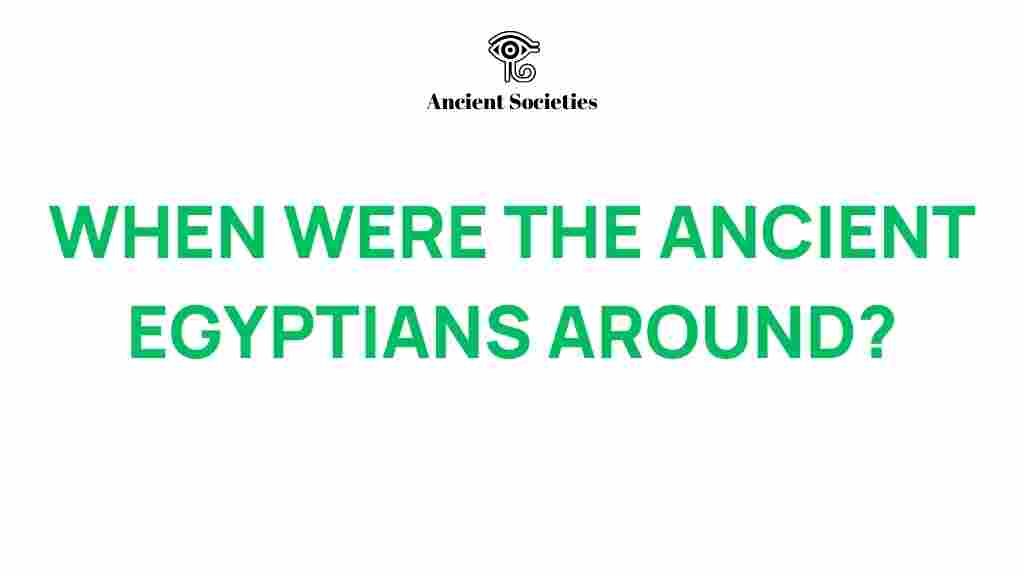Unraveling the Timeline: When Did Ancient Egyptians Thrive?
The story of the Ancient Egyptians is one of the most captivating narratives in human history. This civilization, known for its remarkable achievements, profound culture, and complex society, flourished along the banks of the Nile River for thousands of years. Understanding the timeline of Ancient Egyptians not only helps us grasp their contributions to history but also sheds light on the legacy they left behind. This article will explore the key periods, notable Pharaohs, and the rich culture that defined this extraordinary civilization.
The Early Origins of Ancient Egyptian Civilization
The timeline of Ancient Egyptians begins around 3100 BCE, marking the unification of Upper and Lower Egypt under the first Pharaoh, Narmer (also known as Menes). This pivotal moment set the stage for the development of one of the world’s earliest and most influential civilizations.
- Pre-dynastic Period (c. 5000 – 3100 BCE): The foundations of Ancient Egyptian society were laid during this time, with communities forming along the Nile and developing agricultural practices.
- Early Dynastic Period (c. 3100 – 2686 BCE): This era saw the establishment of the first dynasties, the centralization of power, and the creation of hieroglyphics.
The Old Kingdom: The Age of the Pyramids (c. 2686 – 2181 BCE)
The Old Kingdom is often referred to as the “Age of the Pyramids,” during which monumental architecture flourished. Pharaohs like Khufu and Sneferu commissioned the construction of the iconic pyramids, which served as grand tombs and symbols of their divine status.
- Key Achievements:
- Construction of the Great Pyramid of Giza.
- Development of a centralized government and a sophisticated bureaucracy.
- Advancements in arts, writing, and architecture.
The First Intermediate Period: A Time of Turmoil (c. 2181 – 2055 BCE)
Following the glory of the Old Kingdom, Egypt entered a phase of instability known as the First Intermediate Period. During this time, rival factions struggled for power, leading to a breakdown in central authority.
- Significant Events:
- Local rulers gained power, leading to a fragmented society.
- Decline in monumental construction and artistic endeavors.
The Middle Kingdom: A Renaissance of Culture (c. 2055 – 1650 BCE)
The Middle Kingdom marked a resurgence of stability and cultural flourishing. Pharaohs such as Mentuhotep II and Senusret III worked to restore order and expand Egypt’s influence.
- Cultural Developments:
- Literature and art reached new heights, with works like the Story of Sinuhe gaining prominence.
- Enhanced trade relations with neighboring regions, including Nubia and the Levant.
The Second Intermediate Period: The Hyksos Invasion (c. 1650 – 1550 BCE)
The Second Intermediate Period was characterized by the invasion of the Hyksos, a foreign people who introduced new technologies, including the horse and chariot, to Egypt.
- Impact on Society:
- Hyksos ruled over parts of Egypt, leading to a blending of cultures.
- Military innovations influenced future Egyptian warfare.
The New Kingdom: The Height of Power and Culture (c. 1550 – 1070 BCE)
Considered the pinnacle of Ancient Egyptian civilization, the New Kingdom witnessed incredible achievements in architecture, art, and military power. Pharaohs like Hatshepsut, Akhenaten, and Ramses II left indelible marks on history.
- Notable Pharaohs:
- Hatshepsut: One of the few female pharaohs who expanded trade networks.
- Akhenaten: Known for introducing monotheism with the worship of Aten.
- Ramses II: Often regarded as the greatest pharaoh, known for his military conquests and monumental constructions.
The Decline of Ancient Egyptian Civilization
After the New Kingdom, Ancient Egypt faced a series of invasions and internal strife, leading to its decline.
- Late Period (c. 664 – 332 BCE): Marked by foreign rule, including the Assyrians and Persians.
- Greco-Roman Period (c. 332 BCE – 395 CE): The conquest by Alexander the Great and the subsequent Roman rule heralded the end of Ancient Egyptian independence.
Archaeology and the Study of Ancient Egyptian Society
The study of Ancient Egyptians continues to thrive through archaeology. Excavations at sites like the Valley of the Kings and the pyramids of Giza have unveiled countless artifacts, providing insights into their daily lives, beliefs, and culture.
Archaeologists employ various methods to uncover the mysteries of Ancient Egyptian society:
- Excavation: Systematic digging at historical sites to recover artifacts and structures.
- Radiocarbon Dating: Used to date organic materials, helping to establish timelines.
- Hieroglyphic Translation: Understanding inscriptions to decode historical narratives.
Culture and Society of Ancient Egyptians
The culture of Ancient Egyptians was rich and multifaceted, influencing various aspects of their society:
- Religion: Polytheistic beliefs with a pantheon of gods, including Osiris, Isis, and Ra.
- Art and Architecture: Emphasis on monumental structures and detailed artwork, reflecting their religious beliefs.
- Social Structure: Society was hierarchical, with Pharaohs at the top, followed by priests, nobles, and laborers.
Conclusion
The timeline of Ancient Egyptians reveals a civilization that thrived for millennia, leaving an indelible mark on human history. From the construction of the pyramids to the establishment of a rich cultural heritage, the achievements of the Ancient Egyptians continue to captivate scholars and enthusiasts alike.
As we explore the remnants of their society through archaeology, we gain a deeper appreciation for their contributions to civilization. Whether through the eye-catching hieroglyphics or the majestic temples along the Nile, the legacy of the Ancient Egyptians endures, reminding us of the complexities and wonders of human history.
For further reading on Ancient Egyptian archaeology, visit Ancient History Encyclopedia.
To learn more about the dynasties of Ancient Egypt, check out this internal guide.
This article is in the category History and created by AncientSocieties Team
